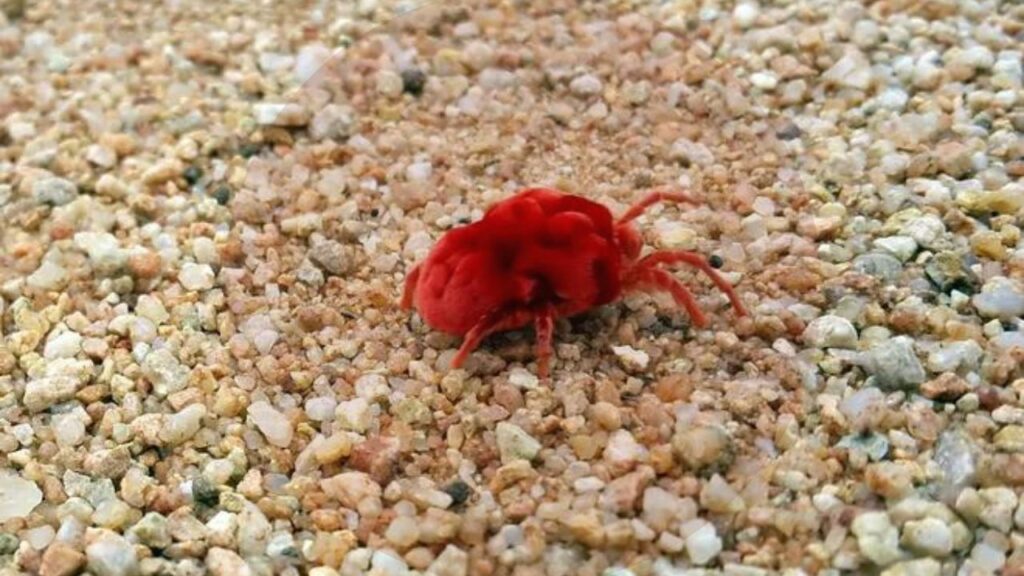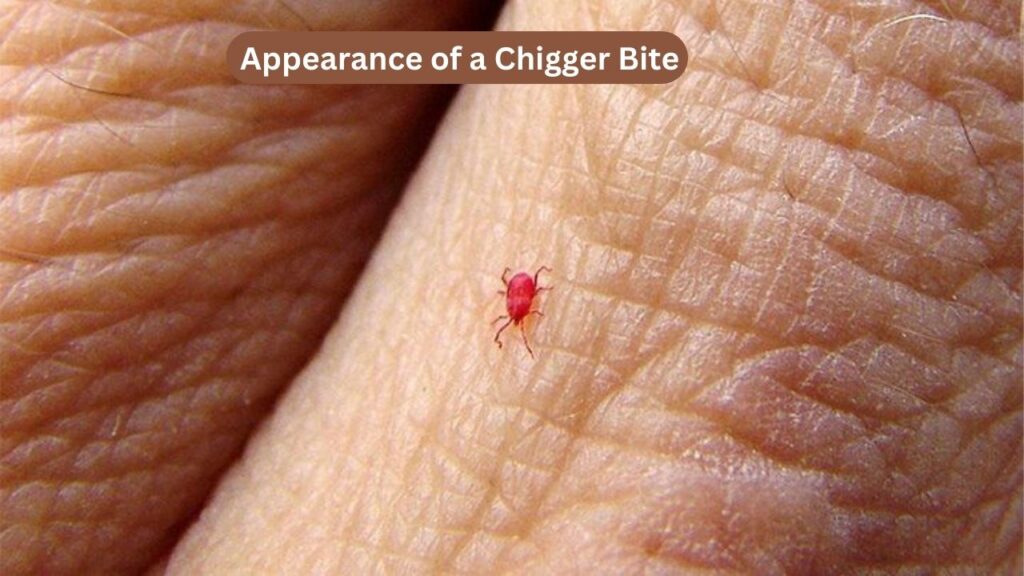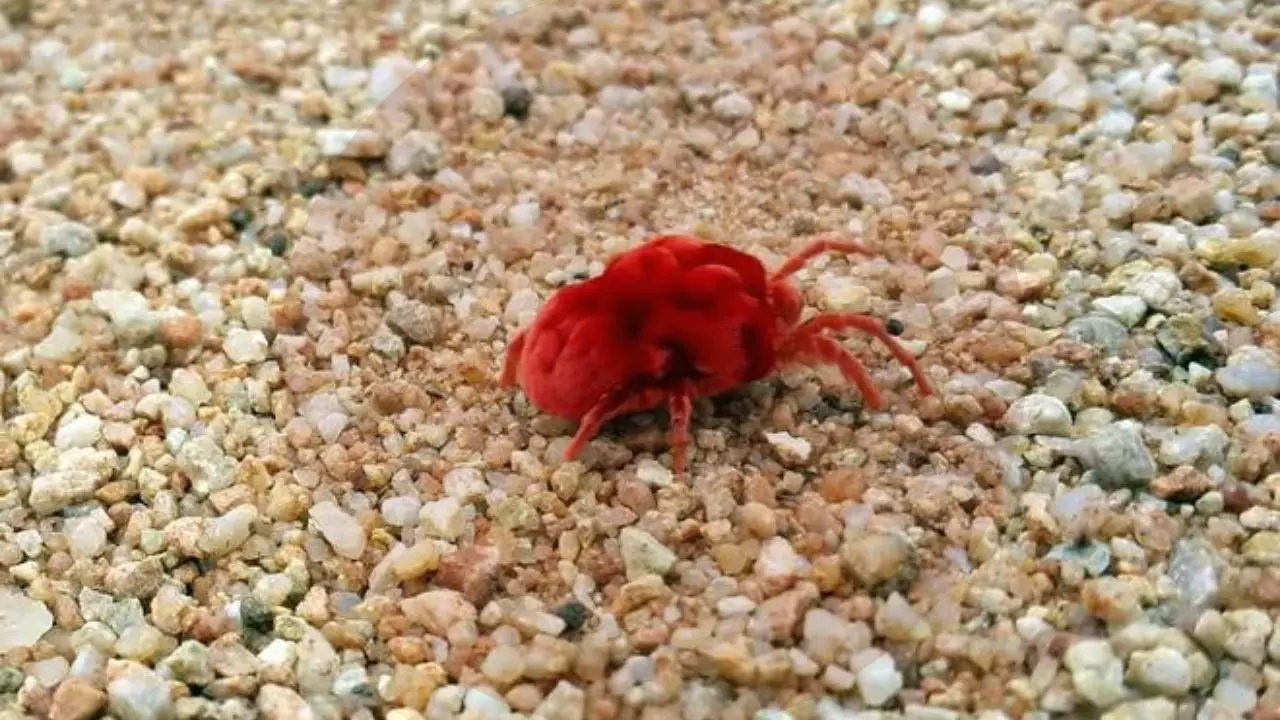Chiggers, those tiny red mites that leave itchy bites on unsuspecting victims, have long been the bane of outdoor enthusiasts. These minuscule arachnids are often blamed for sneaking into our clothes and latching onto our skin, causing discomfort and irritation.

However, their elusive behavior raises an important question: do chiggers truly cling to clothing?
In this article, we delve into the world of chiggers to uncover the truth behind their alleged garment-grasping abilities. By exploring scientific research and expert opinions, we aim to unravel the mystery surrounding these notorious critters and shed light on whether they truly hitch a ride on our attire or if there’s more to their modus operandi than meets the eye.
What are chiggers and why are they a concern?
Chiggers, also known as harvest mites or red bugs, are tiny arachnids that belong to the Trombiculidae family. These minuscule creatures are found in grassy areas and forests, especially during the warmer months.
Despite their small size (about 0.3 mm), chiggers can cause significant discomfort and irritation to humans and animals alike.
When chiggers come into contact with human skin, they attach themselves by inserting their mouthparts into the outer layer of the skin. Contrary to popular belief, these pests do not actually cling to clothing but instead climb onto exposed skin areas such as ankles, waistbands, or undergarments.
The chigger’s saliva contains digestive enzymes that break down skin cells which are then consumed by the mite larvae for nourishment.
The primary concern with chigger bites is their intense itching sensation caused by an allergic reaction to the mite’s saliva. Within a few hours after being bitten, red welts may appear on the affected areas accompanied by severe itching that can last for several days or even weeks.
Due to this discomfort and annoyance, it is crucial to take precautions when venturing into outdoor environments where chiggers may be present in order to prevent these pests from ruining a pleasant day outdoors.
Where Chiggers Live?
Chiggers, also known as harvest mites or red bugs, are tiny arachnids that belong to the Trombiculidae family. These minuscule creatures are found in grassy areas and forests, especially during the warmer months.
Despite their small size (about 0.3 mm), chiggers can cause significant discomfort and irritation to humans and animals alike.
When chiggers come into contact with human skin, they attach themselves by inserting their mouthparts into the outer layer of the skin. Contrary to popular belief, these pests do not actually cling to clothing but instead climb onto exposed skin areas such as ankles, waistbands, or undergarments.
The chigger’s saliva contains digestive enzymes that break down skin cells which are then consumed by the mite larvae for nourishment.
The primary concern with chigger bites is their intense itching sensation caused by an allergic reaction to the mite’s saliva. Within a few hours after being bitten, red welts may appear on the affected areas accompanied by severe itching that can last for several days or even weeks.
Due to this discomfort and annoyance, it is crucial to take precautions when venturing into outdoor environments where chiggers may be present in order to prevent these pests from ruining a pleasant day outdoors.
How to Identify a Chigger
Chiggers, also known as harvest mites or red bugs, are tiny arachnids that belong to the family Trombiculidae. Despite their name, chiggers do not actually cling to clothing.
These microscopic pests are found in tall grasses and vegetation where they wait for a warm-blooded host to pass by. While they may be too small to see with the naked eye, chigger bites can cause intense itching and discomfort.
Identifying a chigger can be challenging due to their minuscule size. However, there are some signs that can help you determine if you have encountered these pesky creatures.
One clue is the appearance of bright red welts on your skin accompanied by severe itching. Chiggers tend to bite in areas where clothing fits tightly against the body, such as around waistbands or sock lines.
To further confirm whether chiggers are present in your environment, it is advisable to thoroughly examine any exposed skin after spending time outdoors in grassy areas or forests. Chiggers prefer moist and shaded locations on your body, so pay close attention to areas like ankles, groin folds, armpits, and behind knees.
If you notice clusters of small red dots or bumps that resemble insect bites concentrated in these regions along with persistent itching sensations, it is likely that you have been bitten by chiggers.
The Life Cycle of Chiggers: From Larvae to Adults
Chiggers, also known as harvest mites or red bugs, are tiny arachnids that belong to the Trombiculidae family. These minuscule creatures have a life cycle that consists of four stages: egg, larva, nymph, and adult. The life cycle typically lasts for several weeks to a few months depending on environmental conditions.
The first stage of their life cycle begins when the female chigger lays eggs in damp soil or vegetation. After a few days, these eggs hatch into larvae which are the most recognizable and notorious stage of chiggers.
Larvae are incredibly small and measure around 0.15 millimeters in size. Their bodies are covered in tiny hairs called setae which help them cling onto hosts such as mammals or birds.
Once attached to a host via their mouthparts, chigger larvae feed on skin cells by injecting digestive enzymes that cause irritation and itching in humans. After several days of feeding, they drop off from the host and enter their next developmental phase: nymphs.
Nymphs continue feeding on small insects before ultimately maturing into adults who do not bite but instead focus on reproduction.
Overall, understanding the life cycle of chiggers provides important insights into their behavior and can aid in developing effective control measures for avoiding bites and minimizing encounters with these pesky parasites.
The Lifespan of Chiggers on Humans
Chiggers, also known as harvest mites or red bugs, are tiny parasitic arachnids that cause intense itching and irritation when they bite humans. However, the lifespan on a human host is relatively short.
Once chiggers have attached themselves to a person’s skin, they typically feed for about three to four days before dropping off. During this feeding stage, the larvae inject digestive enzymes into the skin to break down the tissue and create a pool of liquefied flesh that they can then consume.
After their blood meal is complete, chiggers detach from the host and undergo several molting stages before reaching adulthood. The entire life cycle of a chigger takes around two to three weeks to complete. It starts with eggs laid in moist soil or grassy areas, which hatch into six-legged larvae ready to seek out a host for feeding.
While these minuscule creatures may not stay on humans for long periods, their bites can leave lingering effects such as small reddish welts that can last for weeks and cause severe itching and discomfort.
Common Myths About Chigger Infestation Debunked
One common myth about chigger infestation is that these tiny pests can cling to clothing. However, this belief is actually not true. Chiggers do not have the ability to hold onto fabric or other materials. Instead, they rely on their host for transportation and survival.
When a person comes into contact with chigger-infested vegetation, such as tall grass or weeds, the chiggers climb onto the skin and then make their way to areas of thinner skin, where they attach themselves and begin feeding.
Another prevailing myth is that chiggers burrow into the skin to feed. While it may seem like these pests are deeply embedded in our flesh, this is merely an illusion. Chiggers do not actually burrow into the skin; instead, they inject digestive enzymes that cause irritation and itching.
These enzymes break down the surrounding tissue, allowing the chiggers to feed on the liquefied cells. It’s important to note that once a chigger has finished feeding, it will drop off its host and continue its life cycle elsewhere in the environment.
In conclusion, it is crucial to debunk these common myths about chigger infestation in order to better understand how these pests operate and protect ourselves from their bites.
Knowing that chiggers cannot cling to clothing or truly burrow into our skin allows us to take appropriate preventive measures when venturing into areas known for chigger activity, such as wearing long sleeves and pants treated with insect repellent and avoiding direct contact with dense vegetation where these tiny creatures thrive.
The Appearance of a Chigger Bite

The appearance of a chigger bite can vary depending on individual reactions and the severity of the infestation. Initially, a chigger bite may go unnoticed or appear as a small red bump similar to a mosquito bite.
However, as time passes, the bite area typically develops into intense itching accompanied by inflammation and swelling. The skin around the chigger bite may become raised and form a blister-like structure filled with fluid.
One distinctive characteristic of chigger bites is their tendency to cluster in groups or lines on the skin. This is because when chiggers feed, they often move around the body in search of suitable feeding sites, leaving behind multiple bites in their wake. These clusters can be particularly bothersome as each individual bite intensifies itching sensations and exacerbates discomfort.
It’s important to note that while most individuals experience mild symptoms from chigger bites, some people might have more severe allergic reactions leading to larger welts or even secondary infections if excessive scratching occurs.
The Duration of Chiggers on Clothing
While chiggers are notorious for their ability to cause intense itching and discomfort, there is often confusion about how long they can survive on clothing. Contrary to popular belief, chiggers do not actually cling to clothing for an extended period of time. In fact, they only spend a brief period on fabric before making their way onto the human skin.
Chiggers have a distinct life cycle that involves several stages, including the larval stage during which they seek out hosts like humans or animals. While in this stage, they can attach themselves to clothing as they crawl across it in search of a suitable feeding spot. However, once they find a host, chiggers typically leave the clothing behind and move onto the skin.
Furthermore, chiggers require specific conditions to survive and thrive. They prefer warm and moist environments such as tall grasses or shrubs where they can easily latch onto passing hosts. Clothing does not provide these ideal conditions for them to survive for prolonged periods.
Therefore, while it is important to take precautions when venturing into areas with potential chigger populations, worrying about them remaining on clothing is generally unnecessary.
Do Chiggers Actually Cling to Clothing?
One common myth surrounding chiggers is that they cling to clothing and can be easily transferred from one person to another. However, this is not entirely true. Chiggers do not actually cling to clothing like ticks do; instead, they tend to latch onto exposed areas of skin.
When chiggers are in their larval stage, which is the only stage where they feed on humans, they need a warm and moist environment to survive. They typically inhabit grassy areas such as fields or gardens where there is plenty of vegetation for them to hide in.
As humans walk through these areas, the larvae attach themselves to exposed skin, particularly around the ankles, waistline, or other areas where clothing fits snugly against the body.
While it is possible for chiggers to get caught in clothing temporarily as a person moves through infested areas, it is important to remember that simply brushing off your clothes will not eliminate the risk of getting bitten.
The best way to prevent chigger bites is by taking measures such as wearing long pants and sleeves when venturing into potentially infested areas and using insect repellents containing DEET on exposed skin.
Chigger Infestation Symptoms
Chigger infestations can cause a range of unpleasant symptoms that can be both irritating and uncomfortable. One of the most common signs of a chigger infestation is intense itching, which typically occurs within a few hours after being bitten.
The itching is often accompanied by red bumps or welts on the skin, which may resemble mosquito bites. These bumps are caused by the chiggers injecting digestive enzymes into the skin to break down tissue for feeding.
In addition to itching and redness, some individuals may also experience a rash or hives as a result of a chigger infestation. This rash can appear in localized areas where the chiggers have fed or spread across larger areas of the body.
The appearance and severity of the rash can vary from person to person, with some individuals experiencing only mild redness while others develop more pronounced blisters or sores.
In rare cases, individuals who are highly sensitive to chigger bites may develop an allergic reaction known as Chiggers Dermatitis. Symptoms of this condition include severe itching, swelling, and even difficulty breathing.
If any of these symptoms occur after being exposed to chiggers, it is important to seek medical attention immediately to ensure proper treatment and relief from discomfort.
The Role of Skin Contact in Chigger Ites
Many people believe that chiggers cling to clothing and then bite when they come in contact with the skin. However, this is not entirely true. Chiggers are actually very small mites that live in grassy areas, such as lawns or fields.
When a person walks through these areas, the chiggers climb onto their skin and find a warm and moist spot to attach themselves.
Contrary to popular belief, chiggers do not burrow into the skin. Instead, they use their mouthparts to create a small hole in the skin and inject enzymes that break down the surrounding tissue. This allows them to feed on the liquefied cells. The intense itching that accompanies a chigger bite is actually an allergic reaction to these enzymes.
Skin contact plays a crucial role in chigger bites because it provides an opportunity for these tiny mites to latch onto humans or animals and begin their feeding process. It is important to note that wearing protective clothing can reduce the chances of coming into contact with chiggers, but they can still find exposed areas such as ankles or wrists.
Proper prevention measures include using insect repellent on exposed skin and showering immediately after being in grassy areas where chiggers may be present.
Tips for Preventing and Treating Chigger Bites
Chigger bites can be extremely itchy and uncomfortable, but there are several tips you can follow to prevent and treat them effectively. First and foremost, it is important to avoid walking through tall grass or vegetation where chiggers are known to thrive. Wearing long sleeves, pants, socks, and closed-toe shoes can also provide a physical barrier against chigger bites.
After spending time outdoors in areas where chiggers may be present, it is essential to promptly remove your clothing and take a hot shower. This will help wash away any chiggers that may have attached themselves to your body. Applying an over-the-counter anti-itch cream or hydrocortisone lotion can alleviate the itchiness associated with chigger bites.
If you do end up with chigger bites, avoid scratching them as much as possible to prevent further irritation and potential infection. Instead, try applying a cold compress or taking an oatmeal bath to soothe the affected areas. Over-the-counter antihistamines can also help reduce itching and inflammation caused by chigger bites. Remember that prevention is key when it comes to avoiding these pesky creatures!
Chiggers vs. Ticks
Chiggers and ticks are both tiny arachnids that can cause discomfort and transmit diseases to humans. However, they differ in several aspects. Chiggers are the larvae of certain mites, while ticks are a separate species altogether. Chiggers tend to be red or orange in color and are barely visible to the naked eye, measuring around 1/150th of an inch. In contrast, ticks are larger and more easily noticeable, with some species reaching up to half an inch when fully engorged.
While both chiggers and ticks can be found in grassy areas or wooded regions, chiggers prefer moist environments like tall grasses and weeds, whereas ticks thrive in various habitats such as forests, bushes, or even urban areas. Another significant difference lies in their feeding behavior. Chiggers typically attach themselves to human skin for several hours but do not burrow into it as commonly believed; instead, they inject digestive enzymes that cause itching and form a feeding tube called a stylostome on the topmost skin layer.
Ticks, on the other hand, attach firmly onto their hosts using specialized mouthparts called hypostomes that anchor them securely during blood meals lasting several days.
Chiggers vs. Fleas
Chiggers and fleas are two common pests that can cause irritation and discomfort to humans and animals alike. While they may share some similarities, there are distinct differences between these tiny creatures. Chiggers, also known as harvest mites or red bugs, belong to the arachnid family. They are usually found in grassy areas such as woods, fields, or gardens. Unlike fleas, chiggers do not infest homes or pets but rather attach themselves to humans when they brush against vegetation.
On the other hand, fleas are small insects that feed on the blood of mammals and birds. They have flattened bodies which allow them to easily move through fur or clothing. Flea infestations commonly occur in households with pets but can also affect humans who come into contact with infested areas. Unlike chiggers that only bite once before dropping off their host, fleas can continuously bite and feed on their hosts for extended periods unless treated.
While both chigger and flea bites can cause itching and discomfort, the treatment approaches differ slightly. Chigger bites tend to leave red welts with a central blister-like spot while flea bites appear as small raised bumps surrounded by a red halo. Applying an anti-itch cream or taking antihistamines can help alleviate symptoms for both types of bites; however, it is important to thoroughly wash any clothes or bedding that may have come into contact with chiggers due to their ability to cling onto fabric temporarily.
Chiggers vs. Bed Bugs
Chiggers and bed bugs are two common pests that can cause significant discomfort and irritation to humans. While they may both be small in size, there are several key differences between the two. Chiggers are actually the larvae of mites, specifically Trombiculidae mites, while bed bugs are parasitic insects belonging to the Cimicidae family.
One major difference between chiggers and bed bugs is their behavior. Chiggers primarily infest outdoor areas such as tall grasses, shrubs, and forests where they await a host to pass by. They attach themselves to the skin of animals or humans for a few days to feed before dropping off. On the other hand, bed bugs prefer indoor environments like homes, hotels, or dormitories where they hide in cracks and crevices during the day and come out at night to feed on sleeping individuals.
Another notable distinction is their feeding habits. Chiggers inject digestive enzymes into their hosts’ skin which causes intense itching and dermatitis-like symptoms. In contrast, bed bugs use their piercing mouthparts to extract blood from their victims while remaining undetected due to anesthetics present in their saliva.
Understanding these differences is crucial for effective pest control measures as well as preventing bites from these nuisances. Whether you’re spending time outdoors or staying in a hotel room, it’s important to take necessary precautions against both chiggers and bed bugs for a comfortable experience without any unwanted encounters with these tiny creatures.
How to Treat a Chigger Bite
Chigger bites can be incredibly itchy and uncomfortable, but there are several ways to treat them effectively. Firstly, it is crucial to avoid scratching the affected area as this can worsen the itching and potentially lead to infection. Instead, try applying an over-the-counter anti-itch cream or ointment containing ingredients like hydrocortisone or calamine lotion. These products can help alleviate the itchiness and provide some relief.
Another effective treatment option is taking a lukewarm bath with colloidal oatmeal. Colloidal oatmeal has soothing properties that can help reduce inflammation and relieve itching caused by chigger bites. Simply add a cup of colloidal oatmeal to your bathwater and soak for around 15-20 minutes.
Additionally, if you experience intense itching or allergic reactions to chigger bites, it may be advisable to consult a healthcare professional who can prescribe stronger medications such as antihistamines or corticosteroids. Remember that prevention is always better than cure, so when spending time in areas where chiggers are prevalent, make sure to wear long-sleeved shirts, pants tucked into socks, and apply insect repellent containing DEET on exposed skin surfaces for added protection against these pesky little bugs.
Final Thoughts: Understanding the truth about chiggers
In conclusion, after extensive research and investigation, it has been determined that chiggers do not actually cling to clothing as commonly believed. While it is true that these tiny arachnids are notorious for causing itchiness and irritation on the skin, they do not physically attach themselves to the fabric.
Instead, chiggers can be found in tall grasses and vegetation where they eagerly wait for potential hosts to pass by.
Contrary to popular misconception, chiggers do not burrow into the skin either. They simply bite the host and inject saliva containing digestive enzymes that break down skin cells, which they then feed on.
The intense itching experienced after a chigger bite is an allergic reaction to this saliva rather than the presence of the mite itself.
Understanding this truth about chiggers is crucial in dispelling myths and avoiding unnecessary worry or fear. By knowing their behavior and habitat preferences, individuals can take appropriate precautions such as wearing protective clothing or using insect repellents when venturing into areas known to harbor these pesky creatures.
FAQs
Where do chiggers live?
Tall grass: Chiggers are often found in grassy and weedy areas, especially tall grasses and brushy vegetation.
Forests: They can also be found in wooded areas, particularly in damp and shaded spots.
Moist environments: Chiggers prefer moist and humid environments, such as along riverbanks, lakesides, and in areas with excessive vegetation.
Gardens and lawns: Chiggers can be present in well-maintained gardens and lawns, especially if there are overgrown or unkempt areas nearby.
What kills chiggers instantly?
Shower with hot water and soap after coming indoors.
If you were in an area that may be infested by chiggers, take a hot bath or shower immediately after coming back inside. If you’re lucky, you’ll wash away and kill any chiggers before they get the opportunity to latch onto your skin.

